If you’re staying at The Brakeman Hotel in Tremé, across the street from the French Quarter, you’re already immersed in history. Our hotel is historic too, since it’s located in Basin St. Station, which was the original Norfolk Southern Railway station (circa 1904), the last remaining train station in the city (you can find more details in our “Guest Guide to The Brakeman Hotel Tremé New Orleans.”
Tremé has a lot to offer in terms of history (more on that below), and we don’t need to tell you that the more than 300-year-old French Quarter is a treasure trove of important landmarks and attractions. You’re just steps away from Jackson Square, The Cabildo, and the iconic St. Louis Cathedral, and even strolling around informally, you’ll discover storied landmarks just about anywhere you go.
So, you are here. Welcome! Perhaps you are a history buff or just want to explore what awaits outside the lobby door of The Brakeman. Where do you go? Do you turn left or right? In a city as aware of its living past as New Orleans it might seem overwhelming — even if you’ve come prepared, with a bucket list in hand.
We are here to help. You can always ask for local insider tips and recommendations at the front desk. Also, read on. Here are our top choices for attractions near The Brakeman Hotel. Although it might feel like we’re just scratching the surface, we will never steer you wrong. Here’s a primer, so to speak, starting with Tremé and followed by the French Quarter. If you want more information on the Central Business District (CBD) and the Marigny, read our guide to the “Neighborhoods Near the French Quarter.”
Top Attractions in Tremé
The Brakeman Hotel is located in a historic neighborhood of Tremé. The 442-acre Tremé is defined by Esplanade Avenue to the east, North Rampart Street to the south, St. Louis Street to the west, and North Broad Street to the north.
It’s one of the oldest neighborhoods in the city, settled in the late 18th century and heavily populated by Creoles and free people of color. The area was named after Claude Tremé, a French hatmaker and real estate developer who migrated from Burgundy in 1783.
What is it like today? Tremé is known for its music clubs and soul food spots (some double as both), Creole architecture, and cultural centers celebrating the neighborhood’s African-American and Creole heritage. It’s a vibrant, diverse neighborhood, home of many a second-line parade and the star of popular HBO’s namesake series.
Here are a few “must-visit” attractions within walking distance, or a short car or bike ride away. The beautiful St. Augustine Church is the most famous African American Catholic church in the city (though not the oldest). It was founded by free people of color in 1842. Don’t miss the Tomb of the Unknown Slave, a tribute to the victims of the African diaspora, located on the church grounds at 1210 Governor Nicholls Street. Two blocks away, on the same street, is the New Orleans African American Museum of Art, Culture and History.
Tremé is also home to the excellent Recreation Community Center which has a big indoor pool and a fitness center. You’ll find an incredible collection of Mardi Gras Indian costumes and other cultural memorabilia at the Backstreet Cultural Museum, founded (and manned for many years) by Sylvester Francis.
The Backstreet Cultural Museum is as unique as the city itself. It explores the rites and practices of the city’s African American population that are also interwoven with the French-Creole history of New Orleans. You’ll be led on an unforgettable tour of memorabilia indigenous to Mardi Gras, jazz funerals, second lines, Super Sunday, and other traditions that cannot be found anywhere else in the world.

One of the city’s most famous “cities of the dead,” St. Louis Cemetery No. 1, is located at Basin and St. Louis Streets. (You may remember it from Easy Rider.) Civil rights activist Homer Plessy and voodoo queen Marie Laveau are buried in this cemetery, which was founded in 1789. We recommend booking a guided tour to learn more about this incredible historic place.
Across N. Rampart Street from the French Quarter stretches the 32-acre Louis Armstrong Park, home to the iconic Congo Square, Armstrong’s statue, and several annual food and music festivals. Those include the Tremé Creole Gumbo Festival and the Congo Square Rhythms Festival. At 1419 Basin Street, you’ll find the Mahalia Jackson Theater of the Performing Arts, where you can catch shows featuring everyone from local performers to top touring national acts.
Tremé is said to have invented jazz, and it’s still a great place to hear live music. The Candlelight Lounge is an excellent option for Creole food and brass bands. Kermit’s Tremé Mother in Law Lounge on N. Claiborne belonged to the late R&B and jazz legend Ernie K-Doe and his wife Antoinette. When both passed, Kermit Ruffins bought it and continued the tradition with live music and BBQ.
Want to sample some local soul food? Head to the legendary Dooky Chase’s. The late chef Leah Chase’s Creole staples include gumbo z’herbes, which is not easy to find on the restaurant menus in the city. It’s a meatless version of gumbo made with several types of greens. Beyond gumbo, the menu features New Orleans and Southern staples like BBQ shrimp, Gulf seafood, and amazing Southern fried chicken.
Not far away on Orleans Avenue, owners Greg and Mary Sonnier gave another life to their famous restaurant, Gabrielle, which used to be in Mid-City on Esplanade Avenue but has been shuttered after Katrina. And, speaking of Esplanade, Li’l Dizzy’s Cafe is a popular choice for a casual soul-food breakfast.
This concludes our little tour of the top Tremé attractions, though there’s much more to explore there!
Top Attractions in the French Quarter
Much has been written about the mindblowing variety of options for what to see, eat, drink, and do in the French Quarter, so we’ll refer you to our comprehensive guides, to help you decide what and how to explore the French Quarter. The sightseeing, museum and nightlife choices include famous streets like Bourbon and Chartres streets. Dining opportunities also abound, including eating on a budget and finding late-night options.
Are you on a romantic trip? Need to find things to do on a rainy day? Check out our guides, including which annual New Orleans events not to miss, organized by the season.
Here are a few must-see attractions and landmarks in the French Quarter that are on top of our list.
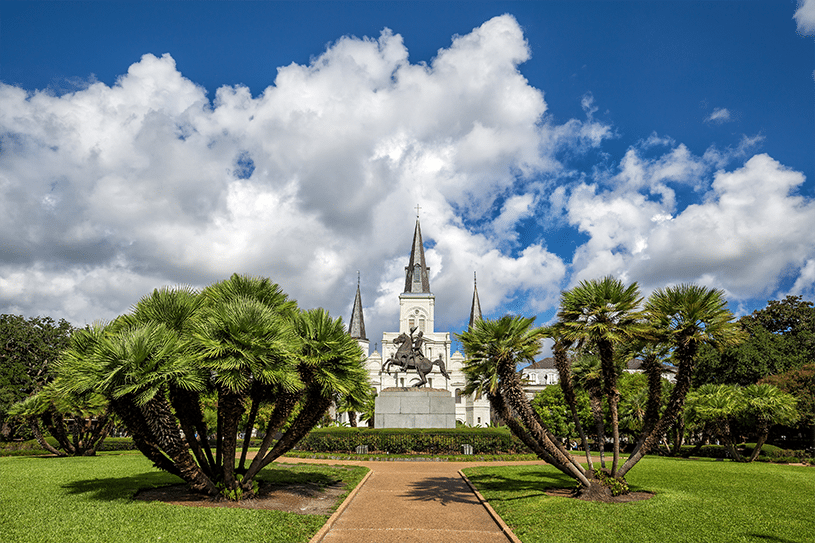
Jackson Square
751 Decatur Street
This timeless landmark is located in the heart of the French Quarter. Known since the 18th century as Place d’Armes, it was renamed in honor of Andrew Jackson following the 1815 Battle of New Orleans. Jackson’s bronze statue is the focal point of the square, surrounded by lavish flora and facing the Mississippi River.
Jackson Square is also a host to the open-air artist market and performance space, with local art displayed along the fence. You can have your sketch done, dance to a brass band, or have your fortune told. Carriage rides are offered in front of the square. When you cross the street to the riverside, you’ll find the French Market, Cafe Du Monde, The Shops at JAX Brewery, and more.
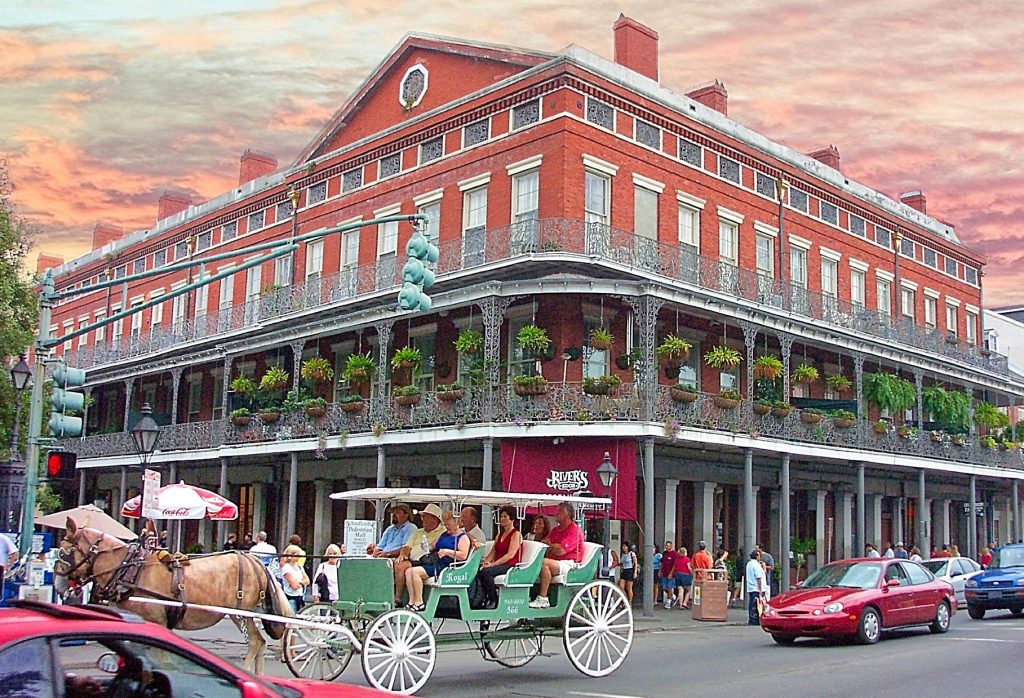
615 Pere Antoine Alley
St. Louis Cathedral is the oldest continuously active Roman Catholic Cathedral in the United States. It stands between its two historic neighbors, The Cabildo and The Presbytere, overlooking Jackson Square and the block-long row of the Pontalba Buildings. St. Louis Cathedral is one of the most instantly recognizable buildings in the world, its famous steeples showing up on many a postcard and in quite a few films.
The Cathedral-Basilica of St. Louis King of France was built in 1724 and had been rebuilt twice after a hurricane and a fire. It was dedicated in 1794 and has enjoyed an illustrious and eventful history. One of its most famous caretakers was Pere Antoine, a popular Capuchin priest who had been pastor of the Cathedral from 1785 to 1790 and again from 1795 to the time of his death in 1829.
You can check out the Cathedral’s stunning interior during its hours of operation, and attend a mass or a music concert. If you’re just passing by, depending on the time of day, you may get to hear its bell or witness an occasional wedding party spilling out of the Cathedral, followed by a second line.
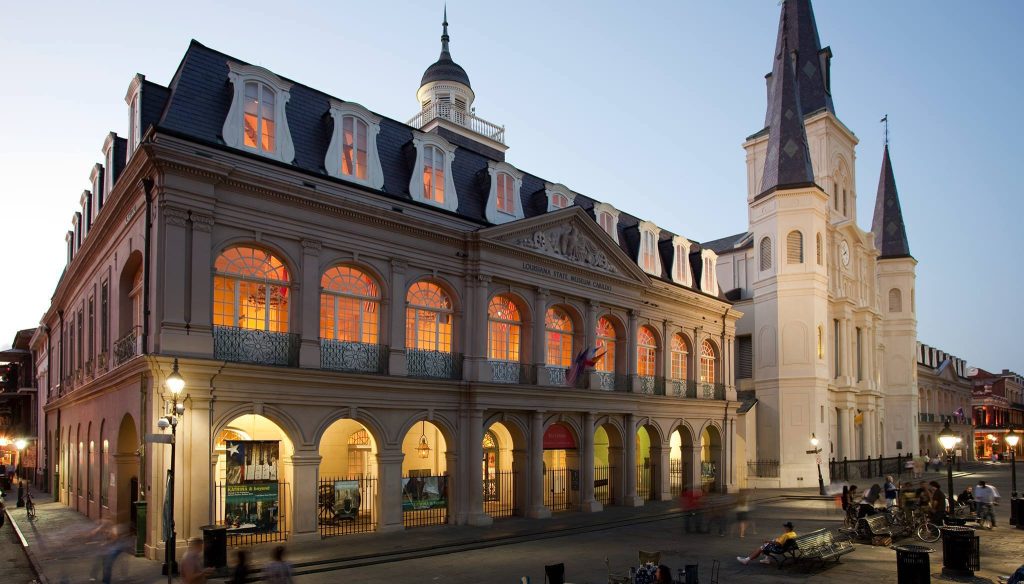
The Cabildo and The Presbytere
701 & 751 Chartres Street, Jackson Square
Did you know that the 1803 Louisiana Purchase was signed at the Cabildo? This historic building served as the seat of government during the Spanish colonial rule, and was built to replace the building claimed by the fire in 1794.
Standing tall right next to St. Louis Cathedral, the Cabildo is now part of the Louisiana State Museum. It houses such precious artifacts as a painting of Marie Laveau by Frank Schneider; a self-portrait by Julien Hudson, an antebellum artist and free man of color; and Napoleon’s death mask, one of only four in the world.
On the other side of St. Louis cathedral is The Presbytere, built in 1791 in the style to match the Cabildo. It’s called “The Presbytere” because it was built on the site of one, which served as a residence for Capuchin monks. The building served as a courthouse in the late 19th century and is now also part of the Louisiana State Museum, just like The Cabildo.
The Presbytere houses several permanent exhibits, including the magnificent “Mardi Gras: It’s Carnival Time in Louisiana,” which tells the story of the Carnival traditions in Louisiana, including Cajun Courir de Mardi Gras, Zulu coconut throws, 19th century Rex ball costumes, and much more. “The Living with Hurricanes: Katrina and Beyond” exhibit documents the natural disaster, its aftermath, and the ongoing recovery with interactive displays and artifacts.
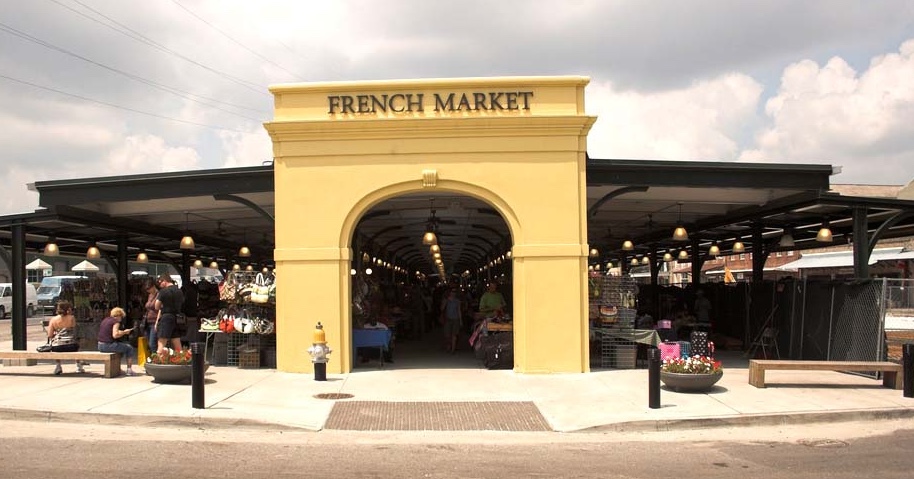
French Market
2 French Market Place
French Market was founded in 1791 as a Native American trading post and has been operating continually since, making it the oldest public market in the country. Similar in structure to a traditional European market, this open-air mall covers roughly five blocks, from Cafe du Monde on Decatur St. across from Jackson Square to the daily flea market at the end of Esplanade Avenue.
Many retail shops and restaurants surround it in every direction. The flea market area hosts dozens of local artisans, plus vendors from all over the world. You’ll find souvenirs, handmade masks and jewelry, t-shirts, music, and more.
French Market also includes a small pedestrian plaza on Dumaine and St. Phillip streets called the Dutch Alley. The food stands at the Farmers Market Pavilion offer a slew of spices, produce and local food that is uniquely New Orleans — from pralines to oysters to the beignet mix or the hot sauce you’d want to take home. The Farmers Market also hosts the annual Creole Tomato Festival to celebrate its harvest.
The Riverfront
1 Toulouse Street
You can access the mile-long riverfront very easily from the Jackson Square area. There you will find the grassy Woldenberg Park and a walkway called the Moonwalk, named after the former New Orleans mayor Maurice “Moon” Landrieu.
Woldenberg Park is a popular spot to watch the 4th of July fireworks. It also hosts one of the largest stages during the annual French Quarter Festival, which takes place in April.
Stroll along the Moonwalk to view public art, like the Holocaust Memorial, and watch the boats go by. The Riverwalk is also home to two popular family-friendly attractions, the Audubon Aquarium of the Americas and the Audubon Insectarium.
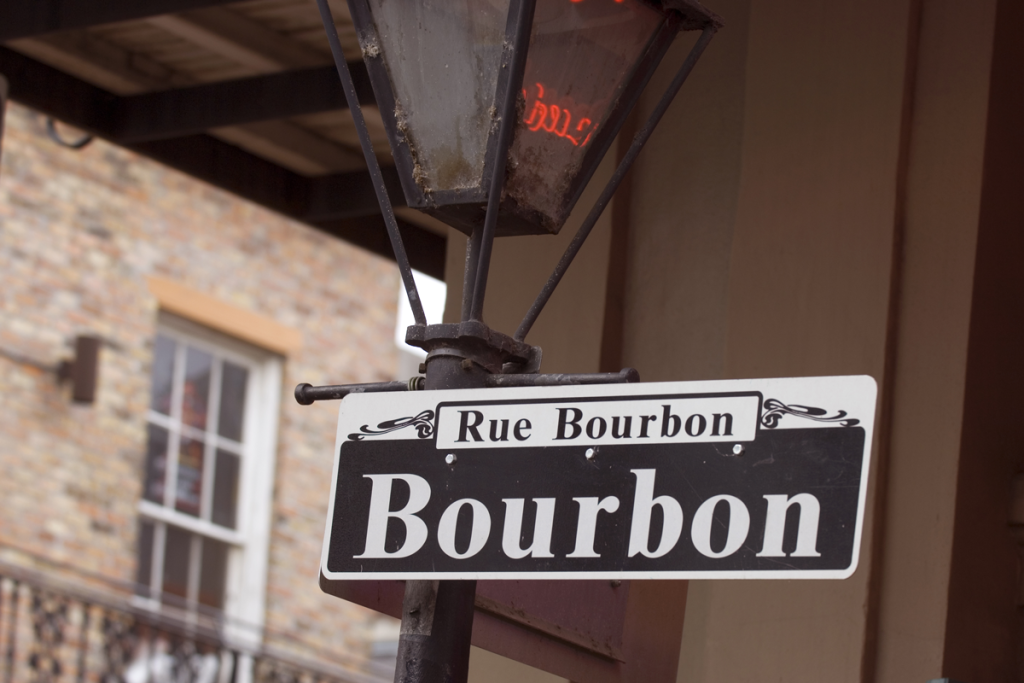
Bourbon Street, French Quarter
That much is true: Bourbon Street is home to one of the wildest nightly street parties in the country. It’s well known for its karaoke and burlesque clubs, bars that never seem to close, and crowds milling about round the clock. This endless party vibe makes Bourbon Street a great destination for your bachelor party, a girls’ night out, spring break, a couple’s getaway — and any other cause for celebration.
It is also one of the oldest streets in the country, a vivid example of Spanish colonial architecture dating back to 1798 and steeped in history, magic and legends. Bourbon Street is home to the city’s most iconic destinations like Galatoire’s and the Old Absinthe House. One of the best jazz clubs in the country, if not the world, also has a Bourbon Street address. Fritzel’s European Jazz Pub is located in a historic 1831 building and hosts live, traditional jazz performances nightly, attracting jazz aficionados from all over the globe.

941 Bourbon Street
This ancient, at least by North American standards, bar is housed in a Creole cottage on the corner of Bourbon and St. Philip streets. Lafitte’s Blacksmith Shop was built between 1722 and 1732, and it’s said to be the oldest structure used as a bar in the U.S. It’s also said to have been used by the infamous Lafitte Brothers, Jean and Pierre, as a base for their smuggling operation in Barataria, operating as a facade for the privateers. We won’t likely know the truth beyond the legend, but the bar is dripping in magic and history, making it a popular destination for locals and visitors alike.
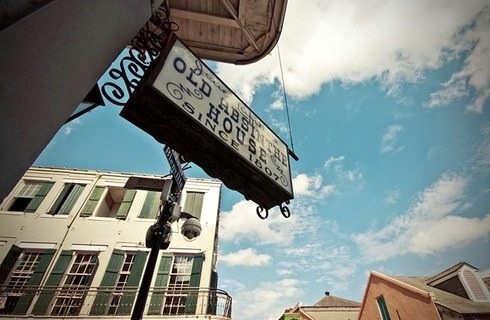
240 Bourbon Street
For nearly 200 years, the Old Absinthe House bar has been a staple for New Orleanians. Here you will find antique chandeliers, along with jerseys and helmets of football legends.
Authentic marble fountains with brass faucets that were once used to drop water over sugar cubes into glasses of absinthe align the bar that seats patrons along the rail. You will have the chance to sample a wide variety of fine malt scotches, house specialties, and, of course, absinthe at this eccentric and historically significant bar.
1100 Chartres Street
The Old Ursuline Convent was built in 1752, which makes it the oldest surviving example of the French colonial period in the country, circa Louis XV. The building first served as a convent for the Ursuline nuns, and then, as centuries ticked on, it had been, at some point: a school, an archbishop’s and priests’ residence, archdiocesan offices/archives, and is now part of the Catholic Cultural Heritage Center of the Archdiocese of New Orleans. Its museum is open for self-guided tours.
Royal Street, French Quarter
Only one block away, running parallel to Bourbon Street, Royal Street presents a very different scene — a mix of performance art, live music on the corners, eclectic art galleries, funky boutiques, and upscale antique shops. The French Quarter part of Royal Street stretches for 13 blocks, from Esplanade Avenue to Canal Street, and the stretch between St. Louis and St. Ann streets is a pedestrian mall closed to traffic from 11 a.m. to 4 p.m. on weekdays and till 7 p.m. on weekends.
The scenic street is also known for its wrought-iron balconies and other charming architectural details and lush courtyards, including those featured by the street’s many restaurants. (How about Bananas Foster in Brennan’s stunning outdoor seating area?)
Among the notable art galleries are Harouni, 933 Royal St., featuring the artist’s own work; and Rodrique Studio, 730 Royal St., with his ubiquitous Blue Dog paintings on display.
As for shopping for antiques, from exquisite chandeliers to rare 17th-century furniture to fine art and jewelry, Royal Street also has you covered. M.S. Rau, 630 Royal St., for instance, is considered one of the best destinations in the world for antique shopping.
For block-by-block guidance, check out our Royal Street Guide.
The Historic New Orleans Collection
533 Royal St. & 520 Royal St.
Dedicated to preserving local history, art and culture, the Historic New Orleans Collection offers a vast trove of materials for both amateur history buffs and academic researchers.
The main 533 Royal St. campus presents free rotating exhibits on subjects ranging from Storyville to the African heritage of New Orleans, while the expansion across the street houses a continuing exhibition of French Quarter history and hands-on installations that make the past come alive. Visitors can also take a guided tour of the Williams Residence, an 1889 Italianate townhouse restored by HNOC founders General L. Kemper and Leila Williams.
Hermann-Grima + Gallier Historic Houses
820 St. Louis St.; 1132 Royal St.
Take a step back in time at these two 19th-century architectural gems, which were restored to their original glory and are filled with period paintings, decorative fixtures, objets d’art and furniture, many of which are original to the homes. Built in 1831, the Hermann-Grima House (820 St. Louis St.) served as a boarding house for unchaperoned working women from 1925 until the mid-’60s, when restoration began.
Home to renowned New Orleans architect James Gallier, Jr. and his family, Gallier House (1132 Royal St.) dates back to 1857 and was restored using Gallier Jr.’s own floor plans and original house inventory. Both homes are open daily as museums and offer guided tours, which visitors can book online.
We hope you enjoy your stay at The Brakeman Hotel and will take advantage of its many amenities and the proximity to the dining, shopping, sightseeing, and entertainment spots of the French Quarter and the Tremé.
Remember, you can walk to all these places from your hotel! Take advantage of our specials, group rates, and best-rate guarantee for greater savings to spend on New Orleans’ famous cuisine and enjoy everything this magnificent city has to offer. Reserve your room today!

